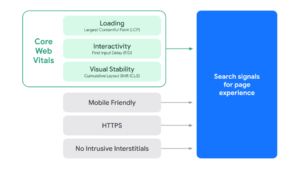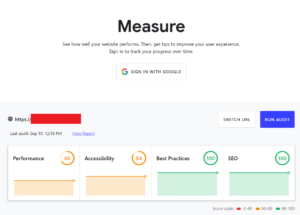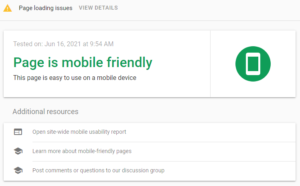Over the last couple of months, there has been an increase in the noise surrounding Google’s Page Experience update and Core Web Vitals. If you are someone like us who tries to keep on top of key digital trends, then you must have heard that Google has now finished rolling out the Page Experience Update. However, If you haven’t a clue about this or haven’t had the time to look into what it is or how it will affect the way your clients’ websites or yours rank in search results, then this post is for you.
First, Let’s Understand – What Is the Page Experience Update?
In November 2020, Google announced what exactly they mean when they say “page experience algorithm update”:
“The page experience signal measures aspects of how users perceive the experience of interacting with a web page beyond its pure information value. Optimising for these factors makes the web more delightful for users across all web browsers and surfaces and helps sites evolve towards user expectations on mobile. We believe this will contribute to business success on the web as users grow more engaged and can transact with less friction.”
In simple terms, Google is looking for how usable your website is, which means user-friendly websites will rank higher than websites that aren’t user-friendly. This means that Google will now be including page experience metrics among the hundreds of other SEO signals it uses to rank websites.
Overview of Google Page Experience Ranking Signals

1. Core Web Vitals (CWV)
Core Web Vitals (CWV) are a set of components that Google will assess to check whether a page provides a good user experience, focusing on the aspects of website loading, interactivity & visual stability. CWV forms a super important part of Google’s overall evaluation of Page Experience update and will make up the most significant chunk of your overall page experience score.
- First, there’s loading experience, measured by the Largest Contentful Paint (LCP), which essentially measures the time it takes for most content/images on a web page to load on the screen. You can check your website’s LCP score using Google PageSpeed Insights.
- Second, there’s the interactive experience, measured by First Input Delay (FID), which measures how long it takes for a user to interact with your web page. Example: Choosing a link from the site’s main menu.
- Finally, visual stability is measured with Cumulative Layout Shift (CLS), which measures how stable your website is, i.e., Do images and page elements move around a lot as the page loads or do they appear seamlessly.
There are multiple tools one can use to measure CWV. The easiest way would be to use Google Lighthouse, which allows you to audit, assess and provide specific recommendations for improving your website in four areas: Performance, Accessibility, Best Practices, and SEO.


2. Mobile-Friendliness


According to a report from Hitwise, nearly 60 per cent of all Online Searches are carried out on a mobile device. Google has already been using mobile-first indexing as the default for crawling new websites. The new Page Experience update will make mobile-friendliness a key ranking signal for web pages. What percentage of searches are performed on mobile devices?
Therefore, if your website does not perform well or fails to deliver a positive user experience via mobile phones, It could hinder your rankings on search results. Google’s Mobile-Friendly Test will tell if your site is mobile-friendly from Google’s perspective. It audits how easy websites are to use and navigate from mobile devices, including the readability of content, where elements are present, and whether links are accessible. It will also give you specific feedback and instructions on how to improve your mobile performance.
3. HTTPS:
The security of its users has always been a top priority for Google. Websites that are not hosted in a secure server and pages not encrypted using a valid SSL certificate will be transmitted via HTTP instead of the HTTPS protocol, which could hinder your ranking performance on Google. Therefore ensuring that your website is secured with HTTPS will be a crucial determinant of how secure the page is for the user and will have an effect on your search rankings.
4. No Intrusive Interstitials:

[Image Source: Google]
By definition, Interstitials are a form of interruption marketing. For example, annoying pop-ups that cover vital sections of the page content or ad banners that interrupt a user’s session on a website, or prevent them from entering the website before dismissing them. As per Google, intrusive interstitials that block users from accessing the content when they first arrive on a page is considered poor user experience.
However, this does not apply to interstitials used for legal reasons such as age verification, cookie pop-ups, login pages, etc.
How will this affect my website rankings & SEO performance?
While this algorithm update was designed to highlight pages/websites that offer excellent user experiences, consider that page experience is only one of many ranking factors that Google considers, so it shouldn’t affect your SEO Performance drastically. Given this, sites generally should not have witnessed any drastic ranking changes as this was a slow roll-out done by Google. So, it’s not like we are dealing with anything new.
While page experience is essential for SEO success, It’s also important to understand that great page experience doesn’t override having great content/information. [Source: Google]
In the meantime, this update is also not to be taken lightly as the Page Experience signals are a combination of multiple ranking factors taken as a whole that are now an intrinsic part of the web. Websites that do not meet that standard can expect to see a dip in visitors, conversions, engagement rates and SEO efforts down the line.
Start Your Digital Journey With IMS
At IMS Marketing, we are constantly helping numerous clients from different industries optimise their websites and create great digital strategies that meet Google’s criteria. We can help you do it too. Please send an email to [email protected] to discuss how we can help your business Get Found Online.
